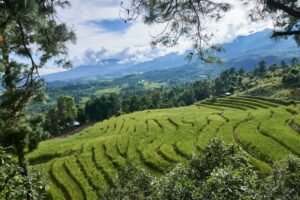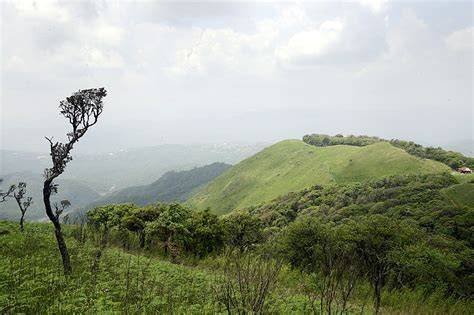In this third installment, Ambassador Gautam Mukhopadhaya moves from vision to implementation. Drawing on successful models from across India’s North East and beyond, he outlines clear, pragmatic strategies to transform farming in the Sadar Hills. This includes a definitive shift away from chemical-based agriculture toward regenerative natural and organic methods, deeper crop diversification for both food and income security, and the protection and promotion of indigenous seeds, crops, and culinary traditions. The goal: to build a resilient, biodiverse farming economy rooted in ecological balance, economic dignity, and cultural pride.
BY Gautam Mukhopadhya
Actionable Steps – Transforming Farming Practices
This section transitions from theory to practice, outlining concrete strategies to transform agricultural practices in the Sadar Hills. It details the needed shift towards sustainable natural and organic farming, crop diversification for both food and financial security, preservation of indigenous seeds, crops, varieties and traditional knowledge, and the need for inclusivity over narrow tribalism in creating a sustainable local economy.
Translating these concepts into practical steps necessitates a multi-pronged action program. Firstly, we must definitively transition, as much as possible, away from chemical fertilizers, pesticides and other synthetic farm inputs, following the exemplary model of Sikkim at the state level. There are numerous ways to achieve this, some of which are already being explored locally such as THRIVE’s organic kitchen gardens and InSIDE NE’s innovative enabling efforts. The principles of Natural Farming, as pioneered by T. Vijaykumar in Andhra Pradesh and Meghalaya, and SALT (Sloping Agricultural Land Technology) farming as demonstrated by David Gandhi in Tamenglong and Noney are inspiring examples and scientifically validated paths that can help move away from synthetic inputs and unsustainable jhum cultivation where traditional jhum rhythms are disturbed. In the Kuki hills, how the issue of land ownership in the hands of Chiefs and tenureship comes in the way of beneficial change too needs to be looked into.
READ :Editorial | Kanwariyas Vs Jawan: A Nation’s Shame
Contrary to the conventional thinking that crops deplete the soil and need to be nourished by chemical or organic inputs, Natural Farming is based on the premise that crops and plants enrich the soil, contributing to a rich web of invisible life—a concept increasingly confirmed by the science of fungi. While farmers addicted to chemical fertilizers may resist, claiming organic methods cannot match yields, they often overlook the well-documented high costs of chemical farming. Furthermore, any perceived loss in productivity is more than offset by gains in value, nutrition, and food safety, underlining the value of quality over mere quantity. Widespread public awareness campaigns are essential for farmers to make informed decisions.
Part 2: A Roadmap for Green Farming in the Northeast Hills https://t.co/ggddXRUXab #Manipur #Sadarhills #RegenerativeAgriculture #NatureFirst #ForestsToFarms #ManipurVoices #TribalWisdom #EcoJustice #ZaboSystem #NorthEastIndia
— Navin Upadhyay (@Navinupadhya) July 19, 2025
Secondly, crop diversification is vital for both food and economic security. Typically, e.g. in Kuki areas, farmers cultivate paddy once a year during the monsoons for food security, supplementing it with seasonal vegetables and foraged foods, leaving fields fallow for much of the rest of the year. While subsistence farming once sufficed, the increasing integration of tribal societies into the wider economy driven by roads, markets, jobs and growing needs for education, health and housing, necessitates dependable cash income. While some surpluses are sold in local markets, the full potential of farming to meet this cash need remains underexploited, with cash income primarily sought through government jobs, private labor, or petty trades. One local farm is experimenting on a small scale with close to 50 cash crops that can be grown year-round along the margins of food crops, potentially providing modest earnings through the year. Crop diversification also offers a crucial form of crop insurance against pests or market failures.
Various online sites detail methods like agro-forestry, tier cropping, horticulture, edge-planting, companion planting (understanding which plants grow well together), and even creating ‘food forests’ and using the Miyawaki method for urban afforestation with native species, all of which can make cultivation more attractive and profitable. While plantations might be necessary for scale, monoculture should be avoided in favour of crop diversity, as a mix is always superior to a single crop both from the point of view of plant health and market fluctuations. Examples from northern Thailand, where coffee, tea, and fruit trees are cultivated together under forest canopies, demonstrate this principle—most plants and trees thrive with companion species.

(Sadar Hills Agricuture)
Farming can also be augmented by ancillary activities like orchid growing, floriculture, mushroom farming, bee-keeping, fish farming, and livestock rearing (dairy, poultry, piggeries, goats, and cattle), which enhance both earnings and nutrition. In the Sadar Hills, agricultural training and extensions Institutions (like FEEDS, KVK, and the College of Agriculture at Hengbung) can provide invaluable scientific and technical assistance. The use of natural cow manure can complete a virtuous organic farming cycle binding communities like the cattle-rearing Nepalis who are part of the Sadar Hills demography and landscape.
READ: Exclusive: We Can Scrap SoO, But Talks Need a Framework: Seilen Haokip
Thirdly, the promotion of indigenous crops, seeds, and varieties—both foraged and cultivated—in the form of traditional and innovative foods, is promising. While a tribal table is incomplete without these traditional foods, their wider market potential, in fresh, cooked or processed forms, remains largely untapped although Naga, Khasi, and Garo communities have made notable inroads into this area. Initiatives like NESFAS’s ‘Mie Ramiew’ or ‘Mother Earth’ cafes in Meghalaya offer inspiration for promoting tribal and rural culinary cultures for local urban markets and tourism, generating income for village women, and popularizing such foods beyond the community. The establishment of north-eastern tribal eateries, as is now entering metropolitan centres like Delhi could be transformative. Perhaps even more necessary is the establishment of industrial agri-processing centres around the principal farm markets in the NER that could both stimulate agricultural production and soak up the surplus for value-adding, non-farm employment and wider markets.
Beyond commercial potential, we must proactively preserve, revive, and promote indigenous crops, seeds, varieties, and traditional knowledge within our own communities, safeguarding them from the pressures of hybrid and commercial seeds and market forces. There is a growing worldwide movement for ‘heirloom’ seeds, which command a boutique value far superior to mass-produced ‘supermarket’ varieties. We must rescue our heirloom seeds. One effective method is through ‘seed libraries,’ like the one pioneered by Mahan Bora in Jorhat, Assam, who has built a rice seed library, the Annapurna seed library, with over 400 varieties through a loan-return system. In time, entrepreneurs can establish seed ‘banks’ that loan or sell such heirloom seeds for profit, potentially linking to a worldwide network of similar libraries.
Tribal societies can also leverage their unique geography and culture to seek Geographical Indication (GI) tags for crops intimately associated with their lands, as they are doing in some areas such as the Lakadong turmeric of Meghalaya, Manipur’s Chakhao black rice, Sirarakhong chilly and Cachai lemon, and other GI tagged produce from the North East. The Kuki-Zo have lagged behind in identifying, branding and promoting a wealth of cultivated and foraged foods unique or common to their areas. While new crops and varieties can be adopted if they do not harm the environment, promoting traditional and indigenous crops where local farmers possess generations of familiarity, offsets their powerlessness in the face of new crops and techniques, and contributes to sense of pride and worth, a psychological and cultural virtue beyond simple productivity or commercial value.
Lastly, there will always be a debate between small farms and large landholdings and plantations on grounds of productivity, optimization of farm inputs like irrigation, technology, fertilizers etc., and economics of scale. Although to many the answer may be obvious, it is far from being so. Small farms come with their own advantages, while large handholdings come with their share of problems. But the debate also masks a distinction between farming as a way of life, a livelihood, a cottage or family activity and as a ‘culture’ on the one hand, and as an industrial activity and part of a larger machinery of production, on the other.
However, even if ownership of land with Chiefs in the Kuki hills is an issue that needs reforms and consensus building, small landholdings and farms are the dominant pattern of farming in the Sadar Hills and up to nearly 70% nationally. There is no alternative but to work with them. They make for a broad-based pattern of ownership that fits well with the traditional egalitarian nature of tribal society. Any large-scale conversion of small holdings into large landholdings will result in concentration of ownership, dispossession of lands and disruptions in community life that are best avoided at this point of time. Small farms are also more manageable and flexible in response to market factors. Finally, there is no reason why the methods that we are discussing should not lead to enhanced productivity and value for small farm products.
The answer to the issue of volumes and scale lies in aggregation. This can be done in several ways: Self Help Groups (SHGs), Cooperatives (pioneered by Amul and followed up by others like Safal, Mother Dairy etc.) one of India’s biggest unheralded organizational contributions to agriculture worldwide, Farmers Producer Organizations (FPOs), Community Resource Management groups adopted by organizations like NERCORMP, etc. These can be linked to local markets and food processing units for longer shelf life, value adding and rural and urban employment. Ideally, this should be taken up at the district level with the involvement of the district administration.













